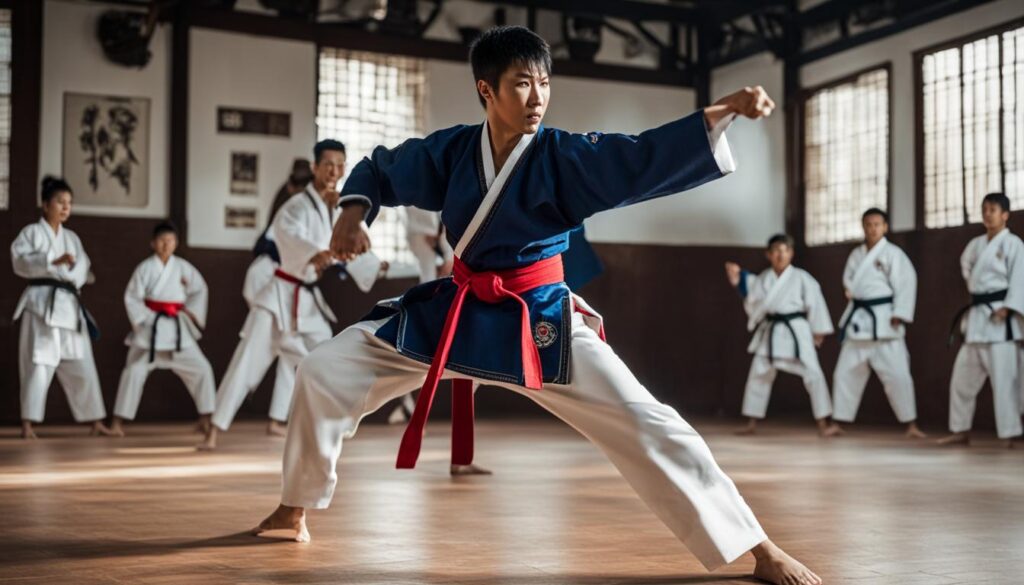Taekwondo is a powerful martial art that offers numerous benefits to those who practice it. From self-defense skills to personal growth, this ancient Korean art form has a lot to offer. Taekwondo focuses on various aspects such as combat techniques, self-discipline, and physical fitness. It enhances flexibility, agility, and cardiovascular endurance, making it an effective choice for individuals looking to improve their overall well-being.
One of the advantages of Taekwondo is its emphasis on self-defense. Practitioners learn powerful and versatile striking techniques that can be useful in real-life situations. Training in Taekwondo also instills discipline, self-control, and stress relief, helping individuals navigate challenges with confidence and composure.
Key Takeaways:
- Taekwondo offers a comprehensive martial arts experience, combining combat techniques, self-discipline, and personal growth.
- It improves flexibility, agility, and cardiovascular endurance, making it a great choice for physical fitness.
- Taekwondo equips practitioners with effective self-defense skills, teaching powerful and versatile striking techniques.
- It fosters discipline, self-control, and stress relief, promoting mental and emotional well-being.
- Practicing Taekwondo creates a sense of community and lifelong friendships.
The Physical Benefits of Taekwondo
Taekwondo, known for its powerful kicks and dynamic movements, offers a wide range of physical benefits. Whether you’re looking to improve your overall fitness or enhance your athleticism, Taekwondo training can help you achieve your goals.
One of the primary focuses of Taekwondo is developing flexibility, agility, and balance. Through the practice of intricate kicks and dynamic movements, practitioners improve their range of motion and overall physical fitness. The fluidity and precision required in executing these techniques not only enhance motor skills but also contribute to improved coordination and body control.
The training routines in Taekwondo are rigorous and demanding, which helps to build cardiovascular endurance. The constant movement and high-intensity workouts strengthen the heart and improve cardiovascular health. The combination of aerobic and anaerobic exercises in Taekwondo training leads to increased stamina, allowing practitioners to sustain physical exertion for longer periods.
Moreover, Taekwondo training hones skills in maintaining optimal distance from opponents and mastering timing. By consistently practicing techniques that require precise control and awareness of space, practitioners develop a heightened sense of spatial perception. This not only benefits self-defense applications but also enhances overall body awareness and coordination in various activities.
The physical benefits of Taekwondo extend beyond the training mats. The discipline and commitment required in regular training sessions promote an active and healthy lifestyle, encouraging practitioners to maintain their physical fitness even outside of class. The consistent engagement in Taekwondo training empowers individuals to take control of their physical well-being and make conscious choices to prioritize their fitness goals.
Whether you aim to improve your flexibility, develop cardiovascular endurance, or enhance your overall physical fitness, Taekwondo offers a comprehensive workout that targets various facets of athleticism.
The Self-Defense Effectiveness of Taekwondo
Taekwondo is renowned for its powerful and versatile striking techniques. Practitioners learn a wide array of kicks, punches, and elbow strikes, which can be invaluable in self-defense situations. These techniques are taught with a focus on precision and control, ensuring that students can defend themselves efficiently. Taekwondo training also emphasizes efficient use of distance and timing for neutralizing threats while minimizing risks.
Taekwondo techniques are designed to maximize the effectiveness of self-defense strategies. By mastering the art of taekwondo, practitioners gain the knowledge and skills necessary to protect themselves in various real-life situations. The emphasis on precision and control ensures that each technique is executed with accuracy and effectiveness.
“Taekwondo teaches practitioners how to react swiftly and confidently, allowing them to defend themselves with ease.”
One of the primary advantages of taekwondo in self-defense is its emphasis on distance and timing. Practitioners are trained to maintain optimal distance from opponents, enabling them to anticipate attacks and respond effectively. By understanding the importance of timing, taekwondo practitioners can neutralize threats quickly and efficiently, minimizing the risk of injury.
In addition to its powerful striking techniques, taekwondo also equips practitioners with grappling and evasion techniques that can be used in self-defense situations. These techniques focus on subduing an opponent or creating an opportunity to escape from dangerous situations.
The combination of powerful strikes, precise control, efficient use of distance, and timing makes taekwondo highly effective in self-defense scenarios. By practicing taekwondo, individuals can develop the skills and confidence necessary to protect themselves and their loved ones.

| Advantages of Taekwondo in Self-Defense |
|---|
| Powerful and versatile striking techniques |
| Precision and control in executing techniques |
| Efficient use of distance and timing |
| Incorporation of grappling and evasion techniques |
The Mental and Emotional Benefits of Taekwondo
Taekwondo emphasizes discipline and self-control as core principles. Practitioners learn to control their impulses, make informed decisions, and channel their energy constructively. The focus required during training, coupled with physical exertion, helps alleviate stress and improve mental clarity. Taekwondo training boosts self-confidence and instills a sense of accomplishment through progressing belts and mastering new techniques. It also fosters self-efficacy and courage in facing challenges.
The Sense of Community in Taekwondo
Taekwondo dojos are more than just training centers; they are vibrant communities that foster a sense of camaraderie among practitioners.
When individuals engage in Taekwondo, they train together, pushing each other to new heights and supporting one another’s growth. The shared experiences create a strong bond that often extends beyond the training mat, resulting in lifelong friendships.
Through the journey of self-improvement and self-defense, practitioners form deep connections as they support and learn from each other. The discipline and dedication required in Taekwondo create an environment where individuals uplift and motivate one another, creating a close-knit community.
In Taekwondo, you’ll find friends who share your passion for martial arts, as well as your commitment to personal growth. Together, you’ll celebrate each other’s achievements, conquer challenges, and forge lifelong friendships that go far beyond the dojo.
Tradition Meets Reality in Taekwondo
Traditional martial arts, such as Taekwondo, hold a rich historical lineage and were originally developed for self-defense purposes. However, in today’s modern world, the concept of self-defense extends beyond physical confrontations. Taekwondo acknowledges this evolving reality by combining tradition with practical self-defense techniques, providing practitioners with a comprehensive education that encompasses various aspects of personal protection.
While some may hold misconceptions about martial arts solely being focused on flashy moves or outdated techniques, Taekwondo embraces the need for well-rounded self-defense education. It goes beyond physical techniques and encompasses vital elements such as situational awareness, conflict resolution, and the ability to navigate complex scenarios effectively.
“Taekwondo combines tradition with the practicalities of self-defense, offering a holistic approach to personal protection.”
By integrating traditional values like respect, discipline, and perseverance with the practical application of self-defense, Taekwondo fosters a comprehensive understanding that prepares practitioners for real-world situations. It empowers individuals with the knowledge and skills needed to protect themselves while promoting personal growth and self-improvement.

Through the rigorous training and practice of Taekwondo, practitioners develop mental fortitude, self-confidence, and the ability to remain calm under pressure. They learn to assess situations, make informed decisions, and defuse potential conflicts rather than resorting to physical confrontation as a first option.
Tradition and reality intersect harmoniously in Taekwondo, creating an educational experience that goes beyond the misconceptions often associated with martial arts. It equips practitioners with the tools to defend themselves and navigate various challenges in today’s world, while simultaneously promoting personal growth, discipline, and respect.
Conclusion
Taekwondo is more than just a martial art; it’s a transformative journey that encompasses the physical and mental aspects of personal growth. Through practicing taekwondo, individuals can achieve empowerment, enhanced physical fitness, and a heightened sense of security.
One of the key benefits of taekwondo is its holistic approach. It not only develops practical self-defense skills but also fosters discipline, confidence, and resilience. Taekwondo teaches practitioners the importance of discipline in all aspects of life, instills self-confidence through progressive achievements, and nurtures resilience by pushing individuals out of their comfort zones.
Beyond the individual benefits, taekwondo also creates a sense of community and lifelong friendships. Training together with fellow practitioners fosters a supportive environment where individuals can learn from each other and grow together. This sense of community enhances the overall experience of practicing taekwondo and ensures that the journey is both fulfilling and enjoyable.
Ultimately, taekwondo is a lifelong pursuit that extends beyond punches and kicks. It provides individuals with the tools they need to become the best versions of themselves. Whether it’s the physical transformation through improved fitness or the mental transformation through increased discipline and confidence, taekwondo offers a comprehensive approach to personal development and empowers individuals to lead well-rounded lives.
FAQ
How effective is Taekwondo?
Taekwondo is highly effective in enhancing self-defense skills, as it combines combat techniques, self-discipline, and personal growth.
What are the benefits of Taekwondo?
Taekwondo offers numerous benefits, including improved physical fitness, cardiovascular endurance, flexibility, agility, discipline, self-control, stress relief, self-confidence, and a sense of community.
How does Taekwondo contribute to physical fitness?
Taekwondo improves physical fitness by emphasizing flexibility, agility, and balance through dynamic movements and intricate kicks. It also fosters cardiovascular endurance through rigorous training routines.
Is Taekwondo effective for self-defense?
Yes, Taekwondo is highly effective for self-defense. It teaches powerful and versatile striking techniques, efficient use of distance and timing, and skills in neutralizing threats while minimizing risks.
How does Taekwondo promote discipline and self-control?
Taekwondo promotes discipline and self-control by teaching practitioners to control their impulses, make informed decisions, and channel their energy constructively.
Does Taekwondo create a sense of community?
Yes, Taekwondo fosters a sense of community and camaraderie through shared training experiences, support for each other’s growth, and the formation of lifelong friendships.
How does Taekwondo blend tradition and practicality?
Taekwondo combines tradition with the practicalities of self-defense, providing a well-rounded education that encompasses physical techniques, situational awareness, conflict resolution, and the ability to navigate complex scenarios.
What are the holistic benefits of Taekwondo?
Taekwondo is more than just a martial art; it offers a pathway to personal growth, empowerment, and a heightened sense of security. It cultivates discipline, respect, resilience, and helps individuals become the best version of themselves.
